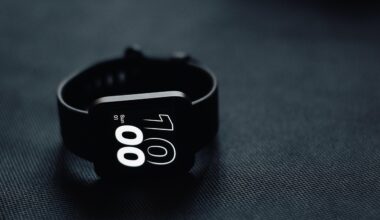Innovative Technologies in Running Apparel for Marathoners
Marathoners understand the significance of high-quality running apparel when it comes to training and race day. Innovative technologies enhance performance, comfort, and safety. Many brands now employ advanced fabrics like moisture-wicking materials and breathable mesh. These features keep runners dry and cool, preventing overheating. Additionally, seamless construction minimizes chafing, ensuring optimal comfort during long runs. Various companies utilize smart textiles that adapt to temperature changes, providing insulation when it’s cold and ventilation when it heats up. Smart apparel can monitor heart rate and other metrics, giving athletes valuable feedback in real-time. Increased visibility is another critical aspect, with reflective elements integrated into the designs, ensuring safety during low-light conditions. Compression garments have gained popularity for their muscle support benefits during strenuous activities, aiding circulation and recovery. Investing in advanced running apparel is crucial for peak performance, allowing marathoners to push their limits. Runners must explore options that enhance their overall experience and enjoy the journey of reaching their marathon goals, thanks to these revolutionary apparel innovations.
Moisture-Wicking Fabrics
Moisture-wicking fabrics represent a significant advancement in running apparel technology, helping athletes maintain comfort during training and races. Unlike traditional cotton, which retains moisture and can lead to discomfort, these specialized materials pull sweat away from the skin, evaporating quickly. This quick-drying feature helps runners feel dry whether they are training in the heat or running long distances. Fabrics like polyester or nylon blend are commonly used to create these high-performance garments that encourage airflow, cooling the skin further. In addition to moisture management, many moisture-wicking fabrics offer UV protection, shielding marathoners from the harmful rays encountered during outdoor runs. Various brands have developed proprietary moisture-wicking technologies, each showcasing unique characteristics. Runners should consider these features when selecting gear. Tagging alongside comfort, durability becomes essential to ensure these garments withstand the rigors of intense training. It’s vital to choose reliable brands that offer warranties or testing to measure the effectiveness of these fabrics. Embracing moisture-wicking apparel can drastically enhance a marathon runner’s experience, paving the way for improved endurance and overall performance.
The integration of breathable mesh panels has fundamentally changed running apparel, significantly increasing ventilation during runs. These strategically placed mesh zones allow for enhanced airflow, helping to regulate body temperature. As marathoners push their limits, maintaining optimal thermal control becomes paramount. With improved breathability, runners experience less heat retention, which translates into improved comfort during long-distance pursuits. Many runners opt for gear that incorporates these mesh features to customize ventilation levels based on personal preference and environmental conditions. Providing the right balance between breathability and coverage is crucial. Additionally, breathable mesh reduces the overall weight of the apparel, producing lightweight options that keep athletes feeling unburdened during their runs. Adaptation to specific weather conditions is imperative; therefore, brands often experiment with hybrid combinations of woven materials and mesh construction. Investing in apparel with breathable zones can dramatically enhance a runner’s performance while contributing to an elevated sense of comfort. Understanding these technological advancements will help marathoners make informed choices when purchasing apparel that best supports their unique running styles.
Seamless Construction
Seamless construction is another innovation that has transformed running apparel, minimizing chafing and enhancing comfort during extended workouts. Traditional seams can create friction points, leading to irritation, particularly during long races where every detail counts. Through advanced knitting techniques, manufacturers have adopted seamless designs, providing garments with a better fit and enhanced freedom of movement. For marathoners, this means fewer distractions on race day. Furthermore, seamless construction allows for strategic placement of compression zones, which enhance support for targeted muscle groups. High-performance apparel often deploys a mix of braided yarns in their seamless designs, offering stretchability while ensuring durability. Many marathoners endorse seamless apparel for its five-star comfort and support features. These garments often adapt well to various body shapes, appealing to diverse athletes. Ideal for training or competition, seamless apparel boosts confidence, allowing runners to focus purely on performance. It’s essential for marathoners to explore a range of options to find what suits their training regimens best. Ultimately, seamless construction signifies a leap forward, exemplifying the advancements in running apparel technology.
Smart textiles have begun to revolutionize running apparel by integrating technology that monitors vital metrics. These cutting-edge fabrics can be embedded with sensors that track heart rate, calories burned, and distance traveled. By providing real-time feedback, smart textiles become an invaluable training tool for marathoners aiming to optimize their workouts. As technology evolves, the potential for more sophisticated features grows, allowing athletes to analyze their performance through advanced data analytics. Easy integration with mobile devices enhances user experience, empowering runners to make informed decisions about their training intensity, hydration, and pacing strategies. Along with performance monitoring, smart textiles often focus on comfort features as well, improving moisture management and ventilation. Some brands even explore molecular sensors capable of detecting changes in sweating patterns. While smart apparel can carry a more expensive price tag, the potential benefits for performance and injury prevention can outweigh costs. As marathoners embrace technology, they unlock new capabilities for achieving personal bests. The marriage of apparel design and technology ultimately enables a more data-informed approach to marathon training, elevating performance to new heights.
Reflective and High-Visibility Gear
The importance of visibility cannot be overlooked, especially for marathon runners who often train during early morning or late evening hours. Reflective materials and high-visibility colors are integral elements in innovative running apparel design, ensuring safety and awareness. With cars and obstacles prevalent on the roads, these features help runners remain seen by drivers and passersby. Brands have started incorporating reflective elements into both technical clothing and accessories, including jackets, leggings, and running vests. This forward-thinking approach combines function and fashion, allowing runners to express personal style while prioritizing safety. Manufacturers are continuously improving reflective technologies, making them more effective under varied lighting conditions. Furthermore, garments exhibiting bright colors enhance visibility during the day, creating a dual approach to safety. By selecting easily identifiable gear, marathoners can optimize their safety during all their runs. This added layer of security is crucial, as it provides peace of mind. With innovations focusing increasingly on visibility, runners can invest in apparel that effectively combines cutting-edge design with an awareness of the environments they navigate, enhancing their overall training experience.
Compression garments have gained significant traction in the running community, particularly among marathoners seeking enhanced muscle support and recovery benefits. These specialized apparel pieces, designed to fit tightly against the body, improve blood circulation, potentially reducing fatigue during runs. While the science behind compression gear continues evolving, many athletes swear by the positive effects on performance and recovery time. Compression socks, sleeves, and tights have become staples for marathon training. The belief is that throughout intensive workouts, these garments help to control muscle vibration, thus decreasing the risk of injury. Furthermore, incorporating compression gear in post-race recovery routines can aid in muscle soreness alleviation and expedite healing. Marathoners should embrace the benefits of these changing landscape compression options while considering the merits of each item. Brands often deliver a variety of options featuring different compression levels, catering to individual preferences and needs. Benefits extend beyond performance; improved recovery makes it easier for runners to maintain training schedules. Ultimately, compression apparel exemplifies how innovative technologies in running gear continue redesigning the marathon experience, addressing both athletic and recovery aspects effectively.
Reflective materials enhance safety for runners training in low-light conditions. Innovations in running apparel are paramount to enhance comfort, safety, and performance. Runners can navigate the challenges of their sport through innovative running gear and achieve their best results. It is imperative for runners to explore innovative options that boost performance and comfort. Careful selection of running apparel ensures optimal experiences during training and races. Brands continuously experiment with advanced textiles to design the best possible attire. Seamless designs minimize friction and maximize comfort during long runs. New technologies are incorporated into running apparel for improved visibility and safety. Keeping up with advancements can lead to elevated performance outcomes and greater marathon experiences. Selecting running apparel that combines these cutting-edge qualities is beneficial to marathoners. Increased performance and comfort through advanced garment technology ensure that athletes can train and compete effectively.


